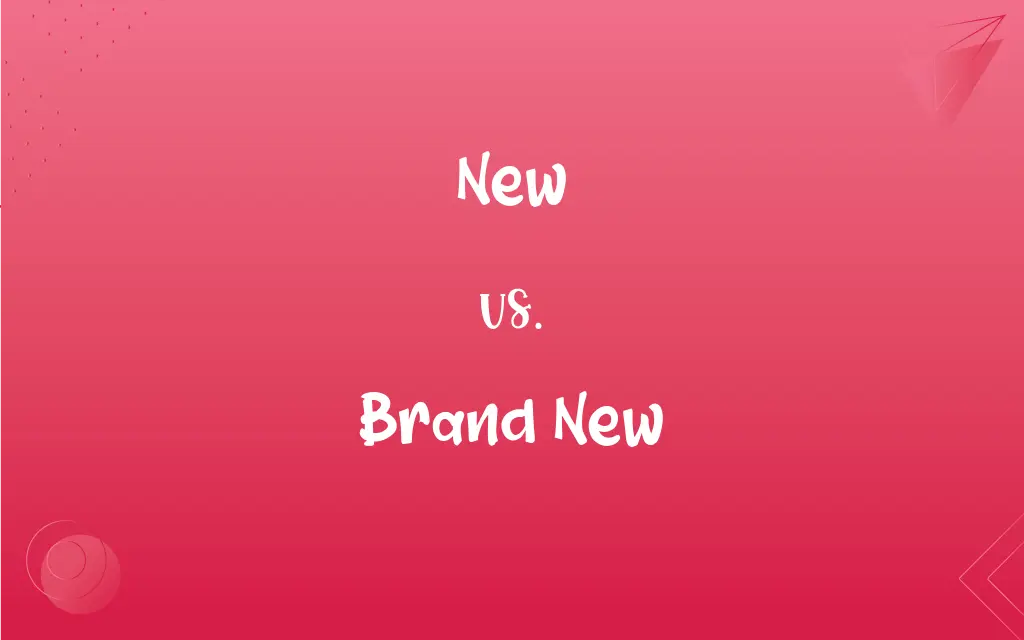New vs. Brand New: What's the Difference?
Edited by Aimie Carlson || By Harlon Moss || Published on March 5, 2024
"New" refers to items that have never been used or owned previously, while "brand new" emphasizes the item's condition as being absolutely untouched and in its original packaging, often directly from the manufacturer.

Key Differences
The term "new" is used broadly to describe items that are fresh, unused, or recently introduced, regardless of their packaging or whether they have been displayed or handled. "Brand new," however, carries a connotation of being in pristine condition, implying that the item has not only never been used but also has never been opened or handled beyond its initial manufacturing and packaging process. This distinction is particularly relevant in consumer goods, where "brand new" items are often sought for the assurance of untouched quality and full manufacturer warranties.
In retail contexts, "new" can apply to items that are the latest versions or recently stocked, even if they've been on display or in open boxes. Conversely, "brand new" items are typically sold in sealed packaging, offering consumers the confidence that they are the first to own and use the product. The expectation with "brand new" is also that the item comes with all original accessories, manuals, and warranties, reflecting its untouched status.
The distinction extends to the perception of value and price. "Brand new" items are often perceived as more valuable and are usually priced higher than items simply labeled as "new," especially in secondary markets like online auctions or resale shops. This is because the "brand new" label assures buyers of the item's condition as being equivalent to purchasing directly from a store or manufacturer.
In marketing, the emphasis on an item being "brand new" can be a powerful tool to attract buyers looking for the latest and most pristine products. Retailers and manufacturers might use "brand new" to highlight the release of the latest models or to assure customers of the condition of their products, especially when selling online or in environments where the buyer cannot physically inspect the item before purchase.
However, the practical difference between "new" and "brand new" can vary by context and is sometimes subject to interpretation. While "brand new" clearly denotes an item's pristine and untouched condition, the term "new" is more flexible, potentially encompassing items that are unused but may have been opened or handled for purposes like display or inspection.
ADVERTISEMENT
Comparison Chart
Condition
Unused, but may have been opened or displayed
Absolutely untouched, in original sealed packaging
Packaging
May or may not be in original packaging
Always in original, unopened packaging
Price
Generally lower than brand new items
Typically priced higher due to pristine condition
Perceived Value
High, but varies depending on handling and packaging
Highest, due to assurance of untouched quality
Usage
Broad, can include latest or recently introduced items
Specific, emphasizing pristine condition and original packaging
ADVERTISEMENT
New and Brand New Definitions
New
They may be displayed or out of their original box.
The new camera was on display but hasn't been sold.
Brand New
Brand new emphasizes pristine condition.
The car is brand new, straight from the dealership.
New
Their condition can vary slightly.
The book is new, though the cover shows shelf wear.
Brand New
They have never been opened or used.
She won a brand new laptop in a raffle.
New
New items can include the latest versions.
This software is new to the market this year.
Brand New
Brand new items are in their original, sealed packaging.
The brand new phone comes with all factory accessories.
New
New products are unused and recently made.
The store offers new smartphones from last season.
Brand New
It suggests the item comes with full warranties.
Buying a brand new TV ensures a full manufacturer's warranty.
New
New implies recent manufacture or ownership.
We just got a new shipment of kitchen appliances.
Brand New
The term is often used to highlight quality.
For his birthday, he received a brand new set of golf clubs.
New
Having been made or come into being only a short time ago; recent
A new law.
FAQs
Can a product be considered new if it has been opened?
A product can still be considered new if it has never been used, even if opened, but it may not qualify as brand new.
Is there a price difference between new and brand new items?
Yes, brand new items are typically priced higher due to their pristine condition and unopened packaging.
Why do consumers prefer brand new items?
Consumers prefer brand new items for the assurance of untouched quality, complete accessories, and full warranties.
How do sellers differentiate between new and brand new items online?
Sellers differentiate by specifying whether items are in their original sealed packaging (brand new) or if they have been opened but are unused (new).
What should buyers check when purchasing items labeled as new?
Buyers should verify the item's condition, whether it has been opened or used, and if all original accessories and warranties are included.
Are open-box items considered new or brand new?
Open-box items are considered new since they are unused, but they are not brand new because the original packaging has been opened.
Does the term "brand new" impact the resale value of items?
Yes, items labeled as brand new typically have a higher resale value, reflecting their pristine, untouched condition.
Can digital products or software be considered brand new?
Digital products, such as software licenses or downloadable content, are often considered "new" due to their nature, but the term "brand new" is less applicable since there's no physical packaging or condition to assess.
Why might a manufacturer label a product as brand new?
Manufacturers label products as brand new to highlight their condition as untouched, directly from the factory, which can justify a premium price and reassure customers about the quality and authenticity of the product.
What role does social media play in the perception of new versus brand new items?
Social media influencers and unboxing videos can heighten the allure of brand new items, showcasing the excitement and perceived value of products in their untouched, original state, influencing consumer preferences.
What ethical considerations arise in the sale and purchase of new versus brand new items?
Ethical considerations include the honesty of labeling products accurately as new or brand new, the environmental impact of producing and disposing of items, and the societal implications of promoting consumerism through the perceived need for brand new products.
How do warranties differ between new and brand new items?
Brand new items come with full manufacturer warranties, while warranties for new items may vary, especially if not in original packaging.
Can an item be sold as brand new if it was returned unopened?
If an item was returned unopened and remains in its sealed packaging, it can often be sold as brand new.
How does the distinction between new and brand new affect consumer trust?
Accurately labeling items as new or brand new builds consumer trust, as it provides transparency about the item's condition and history.
What factors influence the decision to buy new versus brand new items?
Factors include the buyer's budget, the importance of the item being in pristine condition, warranty considerations, and whether the item is a gift, with brand new items often preferred for gifting due to their untouched state.
How do retailers manage inventory labeled as new versus brand new?
Retailers often separate inventory into categories based on condition and packaging, with brand new items often stored differently to ensure they remain sealed and untouched, thereby maintaining their status and value.
How does consumer perception of new versus brand new items affect marketing strategies?
Marketing strategies often emphasize the "brand new" aspect to tap into consumer desires for pristine, high-quality products, leveraging this perception to enhance product appeal and justify pricing strategies.
How do product reviews impact the sale of new versus brand new items?
Product reviews can significantly affect the sale of both new and brand new items, with consumers often looking for reassurance about the condition and reliability of products, especially when purchasing online where physical inspection isn't possible.
What is the environmental impact of preferring brand new over new items?
Preferring brand new items can lead to increased production and packaging waste. Choosing new items, especially open-box or refurbished products, can be more environmentally friendly by reducing waste and the demand for new resources.
How do return policies differ for new and brand new items?
Return policies may be stricter for brand new items to ensure they remain in sellable condition, whereas policies for new items might be slightly more lenient given their already opened or potentially handled state.
About Author
Written by
Harlon MossHarlon is a seasoned quality moderator and accomplished content writer for Difference Wiki. An alumnus of the prestigious University of California, he earned his degree in Computer Science. Leveraging his academic background, Harlon brings a meticulous and informed perspective to his work, ensuring content accuracy and excellence.
Edited by
Aimie CarlsonAimie Carlson, holding a master's degree in English literature, is a fervent English language enthusiast. She lends her writing talents to Difference Wiki, a prominent website that specializes in comparisons, offering readers insightful analyses that both captivate and inform.































































